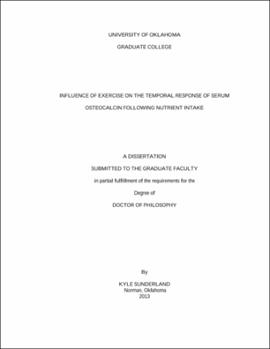| dc.description.abstract | Osteocalcin, also known as bone ã-carboxyglutamic acid, is an osteoblast-specific protein that has long be utilized in research as a marker of bone formation. Recently, osteocalcin has been recognized as a major regulator of glucose metabolism and insulin sensitivity. Osteocalcin deficient mice were shown to have decreased insulin secretion and insulin sensitivity and injections of recombinant osteocalcin reversed these dysfunctions. Furthermore, osteocalcin has been associated with obesity and insulin resistance in human adults. Osteocalcin has also been shown to transiently decrease following ingestion of a glucose load, while acute and long-term exercise has been shown to elevate osteocalcin in adults. Few studies investigating the temporal effects of glucose and/or exercise on osteocalcin levels have been published. Determining how OC responds to exercise and nutrients may help the understanding of how exercise influences glucose metabolism and lead to OC becoming a potential therapeutic target for type 2 diabetes. Therefore the purpose of this study is to examine the effects of a glucose load with or without a prior exercise bout on serum osteocalcin in overweight young men. Fifteen overweight young men were recruited. Subjects reported to the lab on three separate occasions. On two separate trials, conducted on in randomized order and separated by at least 4 days, serum carboxylated osteocalcin, undercarboxylated osteocalcin, glucose and insulin were measured during a standard 75-gram, 2-hour oral glucose tolerance test (OGTT). During one visit the subjects rested prior the glucose drink, while on the other visit aerobic interval exercise (EX) was performed just prior to ingestion of the glucose. There were no significant differences between the OGTT and EX trials in baseline serum cOC (32.24±21.32 vs 26.86±15.68 ng/mL, respectively), serum uOC (8.48±3.23 vs 9.03±3.68 ng/mL, respectively) or serum tOC (40.72±20.88 vs 35.90±17.98 ng/mL, respectively). There were also no significant differences between the OGTT and EX trials for cOC AUC (3466±2238 vs.3345±1873 ng min/mL, respectively; p=0.470), uOC AUC (932±385 vs. 989±422 ng min/mL, respectively; p=0.295), or tOC AUC (4399±2319 vs. 4334±2018 ng min/mL, respectively; p=0.727). Additionally, exercise did not alter the blood glucose or insulin concentrations compared to the resting trial. There were no significant associations between measurements of cOC, uOC or tOC and glucose or insulin at baseline or the post-glucose AUC. This study is the first to report the temporal response of serum OC within 2 hours of glucose ingestion. The results of the study reveal that a neither a bolus dose of glucose, nor exercise preceding the glucose drink altered serum cOC, uOC or tOC in sedentary, overweight young men. Additionally, there was no relationship between postprandial changes in serum cOC, uOC or tOC with glucose or insulin with or without a prior exercise bout. Therefore, OC does not appear to play a role in glycemic control in overweight but otherwise healthy young men. | |
